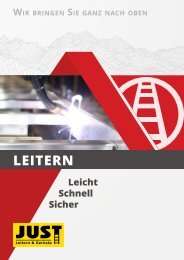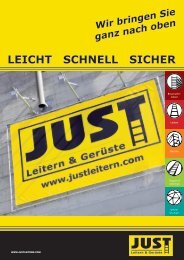Leiternkatalog 2019-04 [EN] WEB
You also want an ePaper? Increase the reach of your titles
YUMPU automatically turns print PDFs into web optimized ePapers that Google loves.
USER INFORMATION<br />
www.justleitern.com/en<br />
Safety instructions<br />
In using a ladder, there are a number of rules to follow to avoid hazards and maintain user safety. When choosing<br />
the right ladder height for your needs, consider the following:<br />
1x<br />
4x<br />
Before climbing, always make sure the<br />
ladder is placed in the correct position.<br />
A leaning ladder applies a tilt angle of<br />
approx. 1:4 or 65º to 75º<br />
1<br />
2<br />
3<br />
STOP<br />
The top two steps or rungs of an A-frame<br />
ladder must not be used for standing, with<br />
the exception of podium ladders or other<br />
platforms specifically built for standing.<br />
1<br />
2<br />
3<br />
4<br />
STOP<br />
The top three steps or rungs of a leaning<br />
ladder must not be used for standing.<br />
This ensures that the ladder will provide<br />
maximum support and stability.<br />
1<br />
2<br />
3<br />
4<br />
5<br />
STOP<br />
When climbing a combination ladder in<br />
freestanding position, the top four steps<br />
or rungs of the extension part must not be<br />
used for standing.<br />
For more information visit www.justleitern.com/products/ladders/user-information/<br />
New features of the <strong>EN</strong> 131 safety standards<br />
Safety standards are used to enforce safe practices of both products and their users.<br />
They protect against accidents at work and form the basis for reliable technical conduct.<br />
We at JUST Leitern AG are aware of our responsibility to our customers, and always design and inspect our products<br />
meticulously to meet these standards.<br />
The new edition of <strong>EN</strong> 131-1 + 2 which has been mandatory for all ladder manufacturers since the beginning of 2018, includes<br />
some new changes in terms of your occupational safety.<br />
> 3,00 m<br />
max. 1,2 m<br />
STAND BROAD<strong>EN</strong>ING FOR LEANING LADDERS<br />
All ladders that are used as leaning ladders and exceed a length of 3 m must be widened at the feet by<br />
using a Stabiliser bar. Alternatively, the stability can be ensured by using hooks to hang the ladder or<br />
additional bracing to create an A-frame support.<br />
The width is a maximum of 1,2 m and depends on the length of the ladder.<br />
> 3,00 m<br />
x<br />
NON-REMOVABLE LADDER PIECES<br />
Removable, independently functional ladder pieces for sliding or multi-purpose ladders longer than 3 m<br />
must either be secured before removal or equipped with a Stabiliser bar according to <strong>EN</strong>-131-1.<br />
1,5 kN<br />
1,5 kN<br />
638 N<br />
2,7 kN<br />
137 N<br />
SAFER LADDERS THROUGH RIGOROUS TESTING<br />
Through a multitude of tests, the quality of each ladder can be guaranteed. Here we provided a brief<br />
overview of test criteria:<br />
■■Strength<br />
■■Torsion and twisting<br />
■■Durability<br />
■■Slip resistance of ladder feet<br />
For<br />
commercial or<br />
private use<br />
For private<br />
use<br />
CLASSIFICATION OF LADDERS<br />
Ladders must be marked for either commercial or private use. Depending on the classification, the ladders<br />
must meet different test requirements. The ladders in this catalogue are already tested to this standard.<br />
The classification can be recognized by the pictogram (see left) next to the ladder type.<br />
For more information visit www.justleitern.com/news/en-131/<br />
22


![Leiternkatalog 2019-04 [EN] WEB](https://img.yumpu.com/62605533/22/500x640/leiternkatalog-2019-04-en-web.jpg)

![Feuerwehrkatalog 2018-07 [DE, WEB]](https://documents.yumpu.com/000/066/454/876/2ff84d4d4fc186f2adb304bc47e5fbad4cb23681/41584a7946314b6a517548766a49427175384c6441773d3d/71736c2f543952465477562b594770723045544536413d3d.jpg?AWSAccessKeyId=AKIAICNEWSPSEKTJ5M3Q&Expires=1719277200&Signature=ZnJHN9Ekpn7v23hdRpG3M7yaWLE%3D)
![Leiternkatalog 2022-02 [DE, WEB]](https://documents.yumpu.com/000/066/436/951/6fbf6364cef8ea3022e6871f4b827b3a906d17d2/7573494f416a36302f6e4f5a4d31463479574d3464773d3d/78356845674739696b6f6379696b56725a69774a62773d3d.jpg?AWSAccessKeyId=AKIAICNEWSPSEKTJ5M3Q&Expires=1719277200&Signature=plInm%2BvcTR1hDfWjRJ6K4RC7sHg%3D)
![Leiternkatalog 2020-01 [WEB]](https://documents.yumpu.com/000/063/096/663/fa98fb26e2d4ade48fc730d0837dc531ab365e37/35372b5852496b3449526f3876792f526553766974773d3d/2b5a6241626647566d2f41547262774b7a65493867673d3d.jpg?AWSAccessKeyId=AKIAICNEWSPSEKTJ5M3Q&Expires=1719277200&Signature=S0yVjXlKJHnYHmsIFRvlNl0sARY%3D)
![Festverlegte Leitern 2019-09 [DE,WEB]](https://img.yumpu.com/62853108/1/184x260/festverlegte-leitern-2019-09-deweb.jpg?quality=85)


![Feuerwehrkatalog 2018-08 [EN] WEB](https://img.yumpu.com/62098575/1/184x260/feuerwehrkatalog-2018-08-en-web.jpg?quality=85)